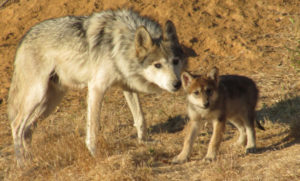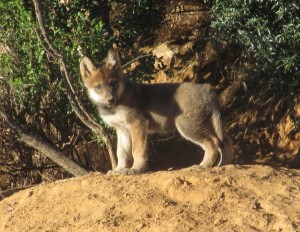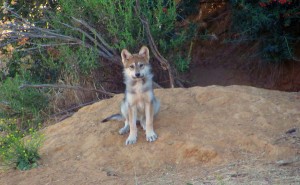They tussle with each other, chew bones and frolic with their parents before hitting the snooze bar under a shady tree. But little f1226, f1227, m1228 and m1229 are more than just new wolf cubs learning the lupus law of the land at the California Wolf Center in Julian — they may be the pups that ultimately bring this endangered species back to health.
“The birth of these four is significant because not only to they add to the number of wolves alive today, but they mother has a rare genetic makeup which makes her valuable for the species, and these pups carry that traits as well,” says Chelsea Davis, Animal Care and Facilities Manager at the center about the pups that were born in April.
See how they grow!
Indeed, compared to the dramatic rebound from the brink of disaster for Gray Wolf in Yellowstone National Park (and the resulting political and bureaucratic bugaboo they have incurred), the road to recovery for the Mexican Gray has been tortoise-like – slow and steady.
In the 1970s, the wolf population was down to seven unrelated individuals. The Mexican Wolf Species Survival Plan kicked into gear in 1977 and in 1998, 50 wolfs were reintroduced in Arizona and New Mexico. Today, there are 352 wolfs in the wild. Breeding centers – like the California Wolf Center – are finding ongoing success with mating and raising of pups, some that will be brought back to their ancestral homeland.
“We’re a big contributor to the program,” says Davis about the center which is the fourth largest breeding facilities for the Mexican GW in the world, and the third largest in the U.S. The U.S. Fish and Wildlife Service (FWS) oversees the breeding of the wolves as well as their reintroduction back into the wild. Some wolves born in captivity have been released to their historic territories in Arizona and New Mexico.
Situated on 45 acres, the center is home to other wolves that are part of the weekend public tour schedule. But Mexican gray wolves are off-limits to the public – they have about 1 ½ acres of land to call their own without human interference in their life and parenting styles.
“Dads play a big role raising the pups,” says Davis. “They are active with the pups and stay close to them. It isn’t just mom raising them. Wolves are very social and in the wild, uncles, aunts and cousins are share the responsibility of raising the pups.”
Knowing that the public really wants to see the pups interacting with each other and their family, Davis has uploaded many photos and videos on the center’s Facebook page – fans and friends “ooh” and “aw” over the images much like they would do for any baby.
Out on an explore
“Mexican gray wolves are very curious but extremely weary of humans,” she says. “But they are wonderful parents and fascinating to watch.” She adds that the wolf has a nickname; the ‘Mexican Jumping Bean’ because can easily clear 7 feet.
All in all, despite being “off limits” in person, this small family pack of wolves has been well documented by staff at the center who is happy to share the experience with the wolf-eager public.
“There is so much information out there now that tells us how important wolves are to the ecosystems they inhabit,” says Davis. “These alpine and desert environments wouldn’t be the same without the wolf. Their presence is needed, now more than ever.”
Click here for more information about the California Wolf Center that will be hosting its annual Wolf Awareness Week in October 1, 2011.
— Story by Brenda Rees, photos courtesy of the California Wolf Center




